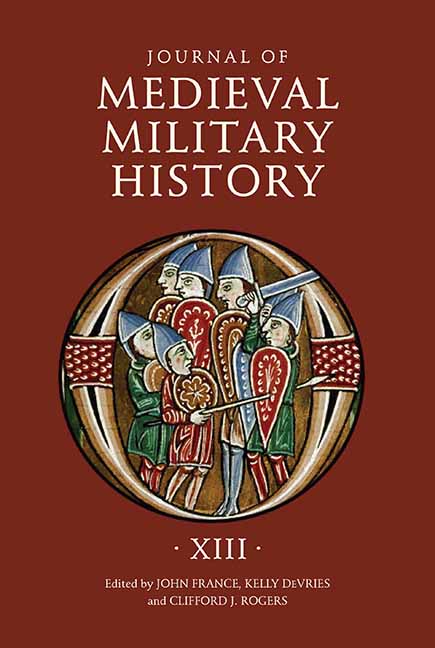Book contents
- Frontmatter
- Contents
- List of Illustrations and Table
- 1 Feudalism, Romanticism, and Source Criticism: Writing the Military History of Salian Germany
- 2 When the Lamb Attacked the Lion: A Danish Attack on England in 1138?
- 3 Development of Prefabricated Artillery during the Crusades
- 4 Some Notes on Ayyūbid and Mamluk Military Terms
- 5 Helgastaðir, 1220: A Battle of No Significance?
- 6 Por La Guarda De La Mar: Castile and the Struggle for the Sea in the Thirteenth and Fourteenth Centuries
- 7 The Battle of Hyddgen, 1401: Owain Glyndŵr’s Victory Reconsidered
- 8 The Provision of Artillery for the 1428 Expedition to France
- 9 1471: The Year of Three Battles and English Gunpowder Artillery
- 10 “Cardinal Sins” and “Cardinal Virtues” of “El Tercer Rey,” Pedro González de Mendoza: The Many Faces of a Warrior Churchman in Late Medieval Europe
- 11 Late Medieval Divergences: Comparative Perspectives on Early Gunpowder Warfare in Europe and China
- List of Contributors
- Journal of Medieval Military History 1477–545X
- De Re Militari and the Journal of Medieval Military History
3 - Development of Prefabricated Artillery during the Crusades
Published online by Cambridge University Press: 25 May 2021
- Frontmatter
- Contents
- List of Illustrations and Table
- 1 Feudalism, Romanticism, and Source Criticism: Writing the Military History of Salian Germany
- 2 When the Lamb Attacked the Lion: A Danish Attack on England in 1138?
- 3 Development of Prefabricated Artillery during the Crusades
- 4 Some Notes on Ayyūbid and Mamluk Military Terms
- 5 Helgastaðir, 1220: A Battle of No Significance?
- 6 Por La Guarda De La Mar: Castile and the Struggle for the Sea in the Thirteenth and Fourteenth Centuries
- 7 The Battle of Hyddgen, 1401: Owain Glyndŵr’s Victory Reconsidered
- 8 The Provision of Artillery for the 1428 Expedition to France
- 9 1471: The Year of Three Battles and English Gunpowder Artillery
- 10 “Cardinal Sins” and “Cardinal Virtues” of “El Tercer Rey,” Pedro González de Mendoza: The Many Faces of a Warrior Churchman in Late Medieval Europe
- 11 Late Medieval Divergences: Comparative Perspectives on Early Gunpowder Warfare in Europe and China
- List of Contributors
- Journal of Medieval Military History 1477–545X
- De Re Militari and the Journal of Medieval Military History
Summary
In 1291, the Mamluk sultan al-Ashraf Khalil brought the largest collection of artillery that had hitherto been witnessed in the theater of the crusades before the walls of Frankish Acre. These machines were immense in both scale and number. However, the progressive development of prefabricated artillery and the logistics that permitted its effective deployment have largely been taken for granted by modern scholarship. Most discussions of medieval mechanical stone-throwers have been consumed by debates over the source of their mechanical power and the amount of force that they were capable of generating. The progressive use and reuse of these engines, by incorporating them into siege trains, has largely been overlooked and the point at which it became more common to transport prefabricated engines to and from a siege, rather than building them anew each time, has remained unappreciated. Like the improvement of the engines themselves, this was the product of a developmental process that spanned beyond the two hundred years of Latin lordship in Syria-Palestine. At its core, this transition was a joint product of technological advancement in artillery science and the logistic capabilities of the period's most powerful figures. It was left to those capable of financing such engines, costly enough to render their storage and movement with an army less expensive than to build them anew, to do so. Although an apparently simplistic balance of cost and value, the issue was made infinitely more complicated when elements of geography, which drove the cost of both construction and transportation up and down by region, political climate and even the changing seasons were factored in.
The siege artillery of the twelfth and thirteenth centuries was of the trebuchet type: engines consisting of a rotating beam that was fixed to an axle at a point that created a disparity between the two arms. When a downward force was applied to the short arm of the beam this movement was augmented at the end of the long arm according to the principle of mechanical advantage. Attached to the tip of the long arm was a sling, which further augmented the velocity of the projectile couched within prior to release.
- Type
- Chapter
- Information
- Journal of Medieval Military HistoryVolume XIII, pp. 51 - 72Publisher: Boydell & BrewerPrint publication year: 2015



